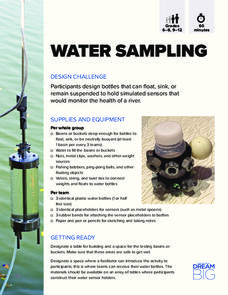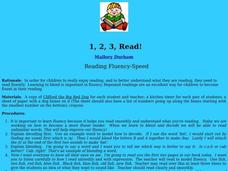Curated OER
Summer Intern
Your young apprentices build a function describing the percent concentration of salt in a brine. The rational function is then related to the parent function, y= 1/x, and graphed. Finally, the apprentices predict the amount of fresh...
UAF Geophysical Institute
System Interactions: The Lorax and the Truffula Tree
If the Lorax were to write a letter, what would he write? Introduce your class to systems and feedback loops through the whimsical stylings of Dr. Seuss. Learners take on the Lorax's point of view to write a letter, among other activities.
Scholastic
Digraph sh
Shhhh! Listen up to learn about the sh digraph. With the materials provided here, kids will have the opportunity to hear, say, write, and read this particular digraph many times.
Poetry Class
Tackling Climate Change
Get your kids thinking about climate change with a series of activities that include creating a ditty box poem for the planet, a poem that identifies concepts or objects they would want to preserve.
E Reading Worksheets
Idioms Test
How well do your class members understand the figurative meaning of idioms? Find out with this 15 question multiple choice assessment.
Novelinks
Tuck Everlasting: Bio-Poem
Learn about the characters of Natalie Babbitt's Tuck Everlasting with a character biopoem. Readers fill in a poem format to detail the character traits of Winnie, Jesse, Miles, and Mae, and share their finished poems...
Novelinks
Tuck Everlasting: Time-Line Graphic Organizer Strategy
What happens first in Tuck Everlasting? What happens after that? Prompt readers to create a timeline of the events in Natalie Babbitt's novel, detailing both story sequence and character relationships.
Balanced Assessment
Disc-Ness
Transform your scholars into mathematicians as they develop their own geometric definition. The task asks individuals to compare cylindrical objects and create a definition for the disc-ness of each object. They may use any method and...
DiscoverE
Water Sampling
What is the best way to test water quality? Using plastic bottles, scholars create monitoring sensors to test water quality. Creating three different sensors allows individuals to measure water quality at different water levels.
Roald Dahl
The Twits - The Glass Eye and the Frog
What do a pair of stinky socks and a toy hamster have in common? The third lesson in an 11-part unit designed to accompany The Twits by Roald Dahl uses silly objects to teach about figurative language. Zany pranks and role play make...
Stanford University
Annexation of Hawaii
Once an independent nation, Hawaii became part of the United States only after a business-sponsored coup of its queen. After examining newspapers from the 1890s, learners consider whether native Hawaiians wished to become Americans at...
American Museum of Natural History
Global Grocery
A walk through the grocery store is like a walk around the world. An interactive activity shows popular grocery items and where the ingredients originate. Perfect as a remote learning resource, the lesson connects groceries to the...
American Museum of Natural History
Ocean Creature Feature
From coloring to hard protective shells, ocean creatures have adaptation features that help them survive. An eight-question online quiz highlights different ocean animals and their unique characteristics. The resource then offers pop-up...
Curated OER
Ratio and Proportion Problems
What is ratio? What is proportion? Two examples are shown before your pupils are given seven problems using either ratio or proportion. Consider having your learners illustrate a selection of the problems provided.
Curated OER
Gummy Candy Count
Use the book, The Gummy Candy Counting Book, to practice counting up to ten objects in a group. This lesson nicely-combines language arts and math in a way that should lead to effective teaching.
Curated OER
Aches and Pains
Being able to distinguish between short and long vowel /a/ sounds is an important skill for young readers. They are introduced to the vowel-consonant-e pattern that changes short vowel sounds into long vowel sounds. They practice reading...
Curated OER
Add and Subtract within 100- Matching Worksheet
There are seven word problems here which test your class's basic addition and subtraction skills. Answers are listed on the right, but they must find the correct one and record the corresponding letter next to the problem. Consider doing...
Curated OER
Capture/Recapture
Young scholars use proportions to estimate the size of populations. They describe the data with using a graph or table of the estimate. Students use descriptive statistics to calculate mean, median, and mode. They also compare and...
Curated OER
1, 2, 3, Read!
Explain to your readers a variety of decoding strategies to improve their reading fluency. They observe the teacher modeling blending, then in pairs take turns reading the book Clifford the Big Red Dog. Learners then time each other...
Curated OER
Multiplying and Dividing Decimals
Division with decimals is explained using prior knowledge of powers of 10 and how to convert both sides of a division problem using this knowledge. The class works together through reading and setting up an equation for a word problem....
Curated OER
Food Pyramid Activity
In this food pyramid worksheet, students fill in their choices in each of the food categories and estimate amounts eaten, then write their goals for food and activity for "tomorrow."
Curated OER
Benefits of Nutrients
Explore the nutrients a body needs using this resource. Learners discuss the importance of the relationships between proteins, fats, carbohydrates, vitamins, minerals, and water. It's a great way to have your class talk about the healthy...
Curated OER
The Job Jungle -- A Labor Market Game
Students work together to participate in a labor market game. They discuss the concepts of supply and demand and how they relate to labor. They ask any questions they have to complete the lesson.
Curated OER
4-H Entomology Project: Insect Collections
Set your students on an exploration of insects with this resource. Learners can get ideas for experiments, investigations and much more. There are five tips for insect collection.

























